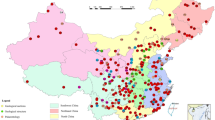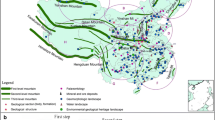Abstract
This study presents the Pearson correlation analyses of the various factors influencing the Chinese National Geoparks. The aim of this contribution is to offer insights on the Chinese National Geoparks by describing its relations with geoheritage and their intrinsic linkages with geological, climatic controls. The results suggest that: 1) Geomorphologic landscape and palaeontology National Geoparks contribute to 81.65% of Chinese National Geoparks. 2) The NNI of geoparks is 0.97 and it belongs to causal distributional patternwhose regional distributional characteristics may be best characterized as’ dispersion in overall and aggregation in local’. 3) Spatial distribution of National Geoparks is wide. The geographic imbalance in their distribution across regions and types of National Geoparks is obvious, with 13 clustered belts, including Tianshan-Altaishan Mountain, Lesser Higgnan-Changbai, Western Bohai Sea, Taihangshan Mountain, Shandong, Qilianshan-Qinling Mountain, Annulus Tibetan Plateau, Dabashan Mountain, Dabieshan Mountain, Chongqing-Western Hunan, Nanling Mountain, Wuyishan Mountain, Southeastern Coastal, of which the National Geoparks number is 180, accounting for 82.57%. 4) Spatial distribution of National Geoparks coincide with latitudinal tectonic zone and longitude tectonic zone of geological structure features, which is consistent with the areas around the Pacific Rim of volcanic tectonic zones. The coupling relationships are obvious between the spatial distributional pattern and the natural and geological conditions.
Similar content being viewed by others
References
Barretino D., Wimbledon W. A. P., Gallego E. (Eds), Geological heritage: its conservation and management. Sociedad Geologica de Espana/Instituto Technologico GeoMinero de Espana/ProGEO, Madrid, 2000
Farsani N. T., Coelho C., Costa C., Geotourism and geoparks as novel strategies for socio-economic development in rural areas, Int. J. Tour. Res., 13(1), 68–81, 2011
Frey M. L., Schäfer K., Büchel G., Patzak M., Geoparks: a regional, European and global policy. In: Dowling R.K., Newsome D. (Eds) Geotourism, sustainability, impacts and management, Elsevier Science, Oxford 95–117, 2006
Hose T. A., Geotourism in Almeria Province, Southeast Spain, Prelim Commun., 55(3), 259–276, 2007
Kiernan K., Human impacts on geodiversity and associated natural values of bedrock hills in the Mekong Delta, Geoheritage, 2, 101–122, 2010
Leite Mansur K., de Souza C., Characterization and valuation of the geological heritage identified in the peródune field, State of Rio de Janeiro, Brazil. Geoheritage, 3, 97–115, 2011
Zhao T., Zhao X., The geoscientific significance and classification of the national geoparks of China, Acta Geologica Sinica, 78(3), 854–865, 2004
Janice E. Bowers, Robert H. Webb, et al., Succession of desert plants on debris flow terraces, Grand Canyon, Arizona, USA, Journal of arid environments, 36, 67–86, 1997
Cleal C. J., Thomas B.A., Bevins R. E., Wimbledon W. A. P., GEOSITES-an international geoconservation initiative, Geology Today, 3, 64–68, 1999
Glasser N., Conservation and management of the earth heritage resource in Great Britain, Journal of Environmental Planning and Management, 44(6), 889–906, 2001
Wolfgang E., Patzak M., Geoparks-geological attractions: tool for public education, recreation and sustainable economic development, Episode, 7(3), 62–164, 2010
William C.M., Derek E. D., Optical properties of aerosols at Grand Canyon National Park, Atmospheric Environment 34, 3373–3391, 2000
Jacob Johannes Smit, Geotourism in South Africa: Problem and Prospects, Rand Afrikaans University 34–39, 2003
Zouros N., The European Geoparks Network, Geological heritage protection and local development, Episodes 27(3), 165–171, 2004
Mansur K.L., Soares da Silva A., Society’s Response: Assessment of the Performance of the “Caminhos Geológicos” (“Geological Paths”) Project, State of Rio de Janeiro, Brazil. Geoheritage, 3(1), 27–39, 2011
Susan T., Geoheritage and Geoparks: One (Australian) Woman’s Point of View, Geoheritage 5, 249–264, 2014
Gray M., Geodiversity: valuing and conserving abiotic nature, Wiley, Chichester, 56–59, 2004
Gordon J. E., Kirkbride V., Rennie A. F., Bruneau P. M. C., Climate change: why geodiversity matters, Earth Heritage, 30, 8–10, 2008
Prosser C., Murphy M., Larwood J., Geological conservation: a guide to good practice, English Nature, Peterborough, 144–149, 2006
Colin D. Prosser, Cynthia V. Burek, David H. Evans et al., Conserving Geodiversity Sites in a Changing Climate: Management Challenges and Responses, Geoheritage, 2, 123–136, 2010
Wang H.Z., Mo X.X., An outline of the tectonic evolution of China, Episodes, 18(1–2), 6–16, 1995
Zhang Y.Q., Ma Y.S., Yang N. et al., Cenozoic extensional stress evolution in North China, Journal of Geodynamics, 36, 591–613, 2003
Jiang Y.B., Guo F.S., Liu L.Q. et al., A study on the features of Danxia landform in Longhushan World Geopark and comparing with others in China. Journal of Mountain Science, 27(3), 353–361, 2009
Zhao T., Zhao X., The basic features and geological setting of the European Geoparks, Geological Bulletin of China 22(8), 637–649, 2003
Zhao X., Zhao T., Geological background of national geoparks of China and construction of world geoparks. Geological Bulletin of China, 22, 620–630, 2003
Zhao T., Zhao X., Geological heritage taxonomy and application. Proceedings of the Second International Symposium on Development within Geoparks, Geological Publishing House, Beijing, 26–97, 2007
Wu J. G., Landscape ecology-pattern, process, scale and level, Higher Education Press 99–105, 2000
Chen A. Z., Some problems about the construction of National geological park of China. Resources & Industries 5(1), 58–64, 2003
Huang J. H., The spatial structure of national geoparks and its relation with some factors of geography in China, Journal of Mountain Science, 23(5), 527–532, 2005.
Li M. L., Jiang J. J., Geological remains in China and its protection, Chinese Geology, (6), 31–34, 2000
Xing L. C., On the protection of geological vestige resources and natural and cultural heritage, Journal of Hefei University of Technology, 18(3), 105–108, 2004
Li X.Q., Zhao X.Y., Construction and development of Geopark, Geography and Geoinformation Science, 19(5), 96–99, 2003
Wei X., Theories and Practices of National Geopark, Beijing: Peking University 6–13, 2005
Peng Y. X., Wu C. J., Harmonious relationship between protection and utilization of geological remains: The case of Shanxi Province, Resources Science, 26(1), 69–75, 2004
Mu G. S., Li D., The problem and countermeasure of the construction of Chinese geopark, Areal Research and Development, 26(4), 79–81, 2007
Wu M., Fu G., The problem and countermeasure of the management of geopark, Acta Agriculture Jiangxi, 20(5), 141–143, 2008
Clark P. J., Evans F.C., Distance to nearest neighbor as a measure of spatial relationships in populations, Ecology, 35, 445–453, 1954
Dacey M. F., A note on the derivation of nearest neighbor distances, Journal of Regional Science, 2, 81–88, 1960
Li S. G., The main reason of the earth’s surface images changes, Geological Society Records of China, 5, 13–14, 1926
Pan J., World culture and nature heritage of China, Beijing: Geological Publishing House 88–125, 1995
Wu S.M., Geological book of China:records from 21 national geoparks, Jinan: Shandong Pictural Publishing House, 25–76, 2005
Wang F.Y., Wang F.B., Wang X.Y., Geomorphology and Quaternary Geology. Beijing: Higher Education Press 24–130, 1991
Liu D., Loess and environment, Beijing: Science Press, 231–286, 1985
Wu C.J., Han L. Y., Tao Y. K. et al., The goordinative operation of National Geoparks based on the protection and utilization of geological remains, Journal of Mountain Science, 22(1), 17–21, 2004
Author information
Authors and Affiliations
Corresponding author
About this article
Cite this article
Wang, F., Zhang, X., Yang, Z. et al. Analysis on spatial distribution characteristics and geographical factors of Chinese National Geoparks. cent.eur.j.geo. 6, 279–292 (2014). https://doi.org/10.2478/s13533-012-0184-x
Received:
Accepted:
Published:
Issue Date:
DOI: https://doi.org/10.2478/s13533-012-0184-x




